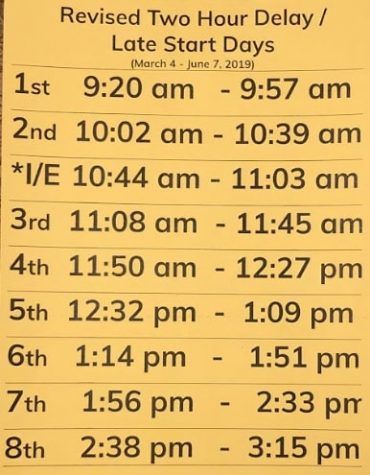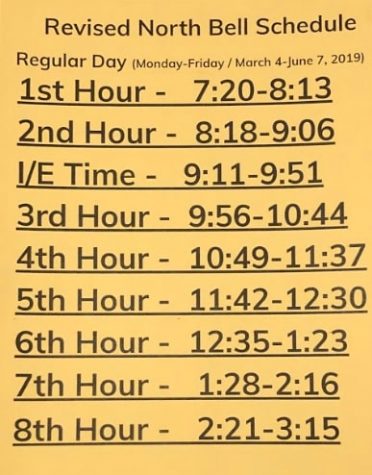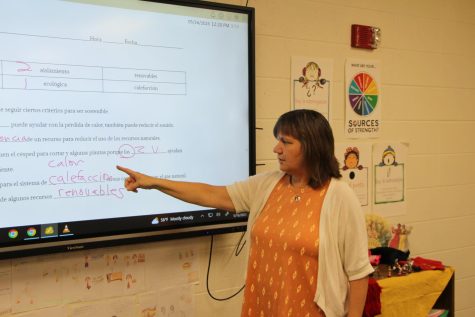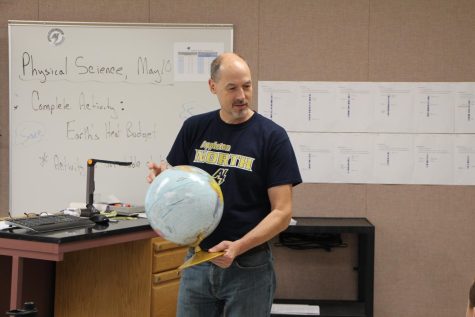Schedule Change Until End of School Year
February 27, 2019
On Monday, March 4, Appleton Area School District will change to a new schedule for elementary and high schools in response to the lost minutes from recent snow and cold days. The schedules (below) will be effective until June 7 and will account for the minutes lost from these days. An email released on Feb. 27 details the new schedule change for all grade levels in AASD, including information on elementary, and middle school changes


Since First and Eighth hour are the most impacted by schedule conflicts, they were given the extra time, and the remainder of the added time went to I/E, said Mr. David Pynenberg, Appleton North High School Principal. The decision to add time to first and eighth was also affected by the way the state of Wisconsin accepts minutes. If all classes received an even amount of minutes throughout the day, the state would only accept 15 of the added 20 minutes, due to the lunch hours working against teaching time. In addition to the longer I/E on the new schedule, two-hour delays now have a 20 minute I/E, in lieu of adding time to other hours. These longer I/E periods will allow for more time for teacher intervention, as well as opportunities for teachers to catch up on lost time, especially for AP classes.
AASD has discussed with and planned for transportation for students to use with the new schedule. The Lamers buses will now arrive at their stops five minutes earlier and leave school ten minutes later, in comparison to the current schedule. Valley Transit buses will arrive ten minutes earlier, and leave five to seven minutes later.
After-school extracurriculars will be changed proportionally. For example, athletes that left early at the end of the day will still have the chance to get to the bus early, but it will now be around 3:05. Large events, like meets or games, that generally run around 4:00 p.m. or 4:30 p.m. remain at these times as they are less affected by the schedule change. Earlier events will be dealt with on a case by case basis.
If an additional full day off would occur, the last day of school would be changed to a full day of school, and one of the two two hour delays scheduled for May would be replaced with a full day of school. This plan was added to preserve plans like Spring Break, which were never on the table for alteration or removal. The extra day would not affect graduates.
The final schedule change decision was necessitated by the change made a few years ago by the state in how they count class time. The state now counts time by the minute as opposed to the number of days, so tacking on days to the end of the school year is less effective at concisely solving the issue of the lost minutes, Pynenberg said. In addition, with summer school starting on Monday, June 10, the district would create more scheduling conflicts by adding days to the end of the school year. There are built in minutes to the normal schedule; however, the large number of days off pushed the district over their amount of allocated minutes. Two-hour delays were an option for removal, but as this time is used for professional development, it was kept for use by staff. The state does allow for schools to alter their bell schedule, and many other districts have. Some have opted to shorten two-hour delays to one-hour delays with additional minutes to the school day, but the majority decided something similar to AASD’s decision, Pynenberg said. The state of emergency called by Wisconsin Governor Tony Evers did dismiss school; however, the Wisconsin Governor does not have the authority to override the amount of time lost during these snow days. The schedule underwent analysis from a representative downtown who then needed to get approval from the state before releasing the new schedule.












Willie Coffey • Feb 28, 2019 at 9:05 am
Yeah bit it dumb tho